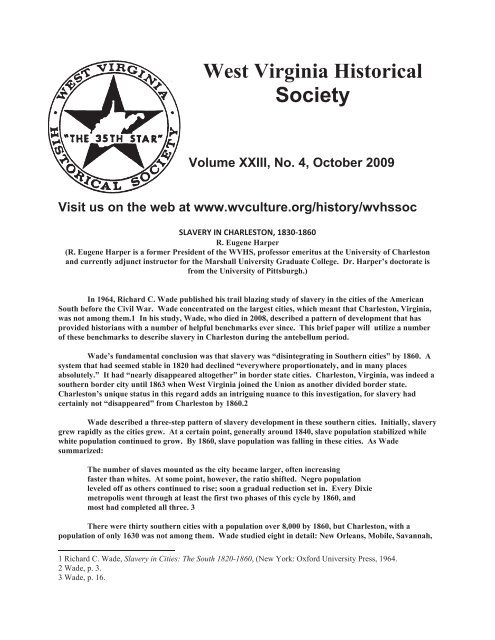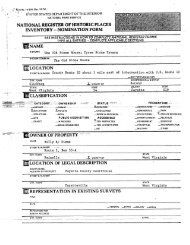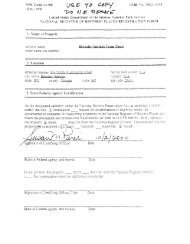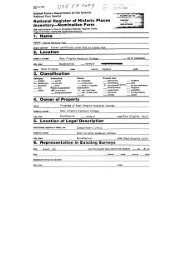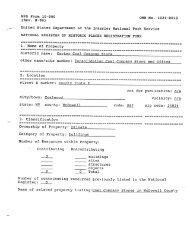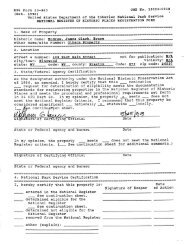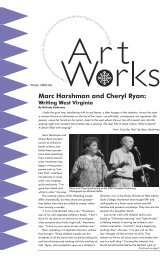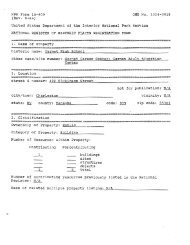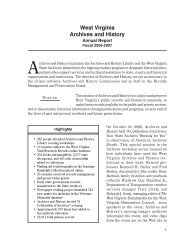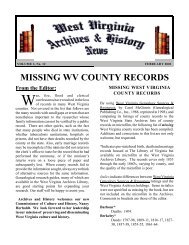Slavery in Charleston, 1830-1860 - West Virginia Division of Culture ...
Slavery in Charleston, 1830-1860 - West Virginia Division of Culture ...
Slavery in Charleston, 1830-1860 - West Virginia Division of Culture ...
Create successful ePaper yourself
Turn your PDF publications into a flip-book with our unique Google optimized e-Paper software.
<strong>West</strong> Virg<strong>in</strong>ia HistoricalSocietyVolume XXIII, No. 4, October 2009Visit us on the web at www.wvculture.org/history/wvhssocSLAVERY IN CHARLESTON, <strong>1830</strong>-<strong>1860</strong>R. Eugene Harper(R. Eugene Harper is a former President <strong>of</strong> the WVHS, pr<strong>of</strong>essor emeritus at the University <strong>of</strong> <strong>Charleston</strong>and currently adjunct <strong>in</strong>structor for the Marshall University Graduate College. Dr. Harper’s doctorate isfrom the University <strong>of</strong> Pittsburgh.)In 1964, Richard C. Wade published his trail blaz<strong>in</strong>g study <strong>of</strong> slavery <strong>in</strong> the cities <strong>of</strong> the AmericanSouth before the Civil War. Wade concentrated on the largest cities, which meant that <strong>Charleston</strong>, Virg<strong>in</strong>ia,was not among them.1 In his study, Wade, who died <strong>in</strong> 2008, described a pattern <strong>of</strong> development that hasprovided historians with a number <strong>of</strong> helpful benchmarks ever s<strong>in</strong>ce. This brief paper will utilize a number<strong>of</strong> these benchmarks to describe slavery <strong>in</strong> <strong>Charleston</strong> dur<strong>in</strong>g the antebellum period.Wade’s fundamental conclusion was that slavery was “dis<strong>in</strong>tegrat<strong>in</strong>g <strong>in</strong> Southern cities” by <strong>1860</strong>. Asystem that had seemed stable <strong>in</strong> 1820 had decl<strong>in</strong>ed “everywhere proportionately, and <strong>in</strong> many placesabsolutely.” It had “nearly disappeared altogether” <strong>in</strong> border state cities. <strong>Charleston</strong>, Virg<strong>in</strong>ia, was <strong>in</strong>deed asouthern border city until 1863 when <strong>West</strong> Virg<strong>in</strong>ia jo<strong>in</strong>ed the Union as another divided border state.<strong>Charleston</strong>’s unique status <strong>in</strong> this regard adds an <strong>in</strong>trigu<strong>in</strong>g nuance to this <strong>in</strong>vestigation, for slavery hadcerta<strong>in</strong>ly not “disappeared” from <strong>Charleston</strong> by <strong>1860</strong>.2Wade described a three-step pattern <strong>of</strong> slavery development <strong>in</strong> these southern cities. Initially, slaverygrew rapidly as the cities grew. At a certa<strong>in</strong> po<strong>in</strong>t, generally around 1840, slave population stabilized whilewhite population cont<strong>in</strong>ued to grow. By <strong>1860</strong>, slave population was fall<strong>in</strong>g <strong>in</strong> these cities. As Wadesummarized:The number <strong>of</strong> slaves mounted as the city became larger, <strong>of</strong>ten <strong>in</strong>creas<strong>in</strong>gfaster than whites. At some po<strong>in</strong>t, however, the ratio shifted. Negro populationleveled <strong>of</strong>f as others cont<strong>in</strong>ued to rise; soon a gradual reduction set <strong>in</strong>. Every Dixiemetropolis went through at least the first two phases <strong>of</strong> this cycle by <strong>1860</strong>, andmost had completed all three. 3There were thirty southern cities with a population over 8,000 by <strong>1860</strong>, but <strong>Charleston</strong>, with apopulation <strong>of</strong> only 1630 was not among them. Wade studied eight <strong>in</strong> detail: New Orleans, Mobile, Savannah,1 Richard C. Wade, <strong>Slavery</strong> <strong>in</strong> Cities: The South 1820-<strong>1860</strong>, (New York: Oxford University Press, 1964.2 Wade, p. 3.3 Wade, p. 16.
WVHS Quarterly October 2009____________________________________________________________________________________________<strong>Charleston</strong>, S.C., Richmond, Baltimore, Wash<strong>in</strong>gton, D.C., Louisville, and St. Louis. In addition to hiscyclical pattern <strong>of</strong> “early dynamic growth, stagnation, and f<strong>in</strong>ally decl<strong>in</strong>e,” Wade noted some other trends <strong>in</strong>these cities: (1) The percentage <strong>of</strong> slave owners was <strong>of</strong>ten higher <strong>in</strong> the cities than <strong>in</strong> the surround<strong>in</strong>gcountryside. (2) The actual number <strong>of</strong> slaves per household was smaller <strong>in</strong> the cities. (3) By the end <strong>of</strong> theperiod, cities were shedd<strong>in</strong>g slaves, particularly males sold <strong>of</strong>f to the countryside. (4) Large hold<strong>in</strong>gs had forthe most part disappeared from these urban centers. (5) By the eve <strong>of</strong> the Civil War, 54 corporations wereown<strong>in</strong>g slaves. To a greater or lesser degree, all <strong>of</strong> these observations also can be tested <strong>in</strong> <strong>Charleston</strong>.4In <strong>of</strong>fer<strong>in</strong>g explanations for this pattern <strong>of</strong> development, Wade concluded that the most significantfactor may have been the growth <strong>of</strong> black neighborhoods and black <strong>in</strong>stitutions <strong>in</strong> these cities where a largefree black population had developed. As he noted: “The problem was not what happened <strong>in</strong> the factory orshop but what happened <strong>in</strong> the back street, the church, the grocery store, the rented room, and the out-<strong>of</strong>-thewayhouse.” It was the “associational life” <strong>of</strong> the free black population, their private lives and contacts thatwere significant <strong>in</strong> slavery’s decl<strong>in</strong>e <strong>in</strong> these cities. <strong>Slavery</strong> required a “high degree <strong>of</strong> order,” but “the citydemanded fluidity.” While other trends described by Wade may have had their echoes <strong>in</strong> <strong>Charleston</strong>, the freeblack population was still much too small for this k<strong>in</strong>d <strong>of</strong> associational life to ga<strong>in</strong> much headway.5<strong>Charleston</strong>, Virg<strong>in</strong>ia, was not much <strong>of</strong> a city before the 1820s. Only <strong>in</strong> <strong>1830</strong> was it large enough to bedesignated as an entity separate from Kanawha County on the federal census. From its formal found<strong>in</strong>g <strong>in</strong>1794, <strong>Charleston</strong> grew slowly. It may have had a couple hundred souls by 1810 and maybe as many as fivehundred by 1820. <strong>Charleston</strong>’s population and <strong>in</strong>stitutional growth <strong>in</strong> large measure paralleled the earlydevelopment <strong>of</strong> the salt <strong>in</strong>dustry <strong>in</strong> Kanawha Valley. Only after a branch <strong>of</strong> the Bank <strong>of</strong> Virg<strong>in</strong>ia opened <strong>in</strong>1832 and a first class hotel, the Kanawha House, opened <strong>in</strong> 1834, did the city have the commercial,governmental, and service trades necessary for real city life.6Once <strong>Charleston</strong> grew large enough to appear separately on the federal census, it becomes possible tocompare the growth <strong>of</strong> slavery <strong>in</strong> <strong>Charleston</strong> from <strong>1830</strong> through <strong>1860</strong> aga<strong>in</strong>st the model described by Wade.In general, <strong>Charleston</strong> did follow the broad pattern <strong>of</strong> Wade’s model.7CHARLESTON POPULATION <strong>1830</strong>-<strong>1860</strong>Population <strong>1830</strong> % 1840 % 1850 % <strong>1860</strong> %White 429 62.8 657 59.7 674 68.8 1208 74.1Free Black 10 1.5 28 2.6 54 5.5 34 2.1Slave 244 35.7 415 37.7 252 25.7 388 23.8Total 683 100% 1100 100% 980 100% 1630 100%From these census reports, it does appear that slavery <strong>in</strong> <strong>Charleston</strong> grew rapidly early, thatpopulation then leveled <strong>of</strong>f after 1840, and that slavery was <strong>in</strong> relative decl<strong>in</strong>e by <strong>1860</strong> as the white population4 Wade, p. 5, 19 (quote), 20-28.5 Wade, pp. 245, 249, 262.6 For <strong>Charleston</strong>’s early development see R. Eugene Harper, “Glenwood 1852. Why? The Context for an HistoricHouse.” Paper presented at the Glenwood Estate Symposium, Marshall University Graduate College, July 28, 2007.Available onl<strong>in</strong>e at: http://www.marshall.edu/gsepd/humn/GlenwoodProject/7 U.S. Federal Census for <strong>1830</strong>, 1840, 1850, <strong>1860</strong> and the <strong>1860</strong> Slave Schedule for Kanawha County, Virg<strong>in</strong>ia,available on micr<strong>of</strong>ilm at the <strong>West</strong> Virg<strong>in</strong>ia Archives, Capitol Complex, <strong>Charleston</strong>. Because each census isstructured differently, direct comparisons are not as simple as it might seem, and each researcher will need to make<strong>in</strong>terpretive decisions. Nevertheless, the general pattern <strong>of</strong> development is not <strong>in</strong> doubt.2
WVHS Quarterly October 2009____________________________________________________________________________________________nearly doubled. While this follows the general pattern described by Wade, clearly by <strong>1860</strong>, slavery had not“nearly disappeared altogether” from this border city, and the growth <strong>of</strong> a free black population was not yet asignificant factor <strong>in</strong> city life.Wade’s broad pattern also holds when one looks at households and slave ownership. The number <strong>of</strong>households reported as own<strong>in</strong>g slaves grew little <strong>in</strong> absolute numbers over the period even as the total number<strong>of</strong> households grew more than threefold. There was essentially no change from <strong>1830</strong> to 1840, a moderatejump by 1850, and a m<strong>in</strong>or <strong>in</strong>crease from 1850 to <strong>1860</strong>.SLAVE OWNERSHIP <strong>1830</strong>-<strong>1860</strong>Households8 <strong>1830</strong> 1840 1850 <strong>1860</strong>White 70 109 133 230Free Black 1 8 7 7Total Households 71 117 140 237Whites with Slaves 58 57 68 72Percentage with Slaves9 83% 52% 51% 30%As a proportion <strong>of</strong> the white population, however, the percentage <strong>of</strong> households report<strong>in</strong>g slavesdecl<strong>in</strong>ed dramatically over the period even as the total number <strong>of</strong> slaves actually <strong>in</strong>creased. Thus, theoverall pattern follows Wade: a high proportion <strong>of</strong> slave owners early on, then a general stabilization,followed by a significant decl<strong>in</strong>e <strong>in</strong> the proportion <strong>of</strong> slave owners by <strong>1860</strong>.If one looks more closely at these numbers, certa<strong>in</strong> complications appear and someref<strong>in</strong>ements need to be made. For example, can the high number <strong>of</strong> slaves (415) <strong>in</strong> 1840 beexpla<strong>in</strong>ed? Or, <strong>in</strong> spite <strong>of</strong> the much smaller proportion <strong>of</strong> slave owners, why were there still so manyslaves <strong>in</strong> <strong>Charleston</strong> <strong>in</strong> <strong>1860</strong>? Note the follow<strong>in</strong>g mean (average) number <strong>of</strong> slaves per owner <strong>in</strong> eachdecade:SLAVES PER CHARLESTON HOUSEHOLD<strong>1830</strong> 1840 1850 <strong>1860</strong>Number <strong>of</strong> Owners 58 57 68 72Slaves per Owner 4.2 7.2 3.7 5.4Contrary to what one might expect from Wade’s model, slave owners appear to have owned moreslaves per owner <strong>in</strong> <strong>1860</strong> than <strong>in</strong> <strong>1830</strong>. As the full distribution <strong>of</strong> slaves per owner shows (see nextpage), most owners held only a few slaves. However, a few owners had many slaves, and these large8 Household does not necessarily imply a separate dwell<strong>in</strong>g. An owner may have lived <strong>in</strong> a board<strong>in</strong>g house or hotel.9 Occasionally slaves were reported liv<strong>in</strong>g with free blacks. In 1840, two s<strong>in</strong>gle female slaves lived with a freeblack woman, Nelly Fry. In 1850, washerwoman, Judy Gr<strong>in</strong>ham, had a free black family (occupation: cooper) and as<strong>in</strong>gle female slave liv<strong>in</strong>g with her. Were these slaves owned by these poor free women, or simply resid<strong>in</strong>g there?Only slaves <strong>in</strong> white households are <strong>in</strong>cluded <strong>in</strong> the percentages.3
WVHS Quarterly October 2009____________________________________________________________________________________________numbers easily skew mean statistics <strong>in</strong> a population this small. A handful <strong>of</strong> owners held more thantwenty slaves, and <strong>in</strong> 1840, one <strong>Charleston</strong> owner claimed 85.If one looks more closely at those ow<strong>in</strong>g twenty or more slaves, it is highly unlikely that many<strong>of</strong> these slaves actually lived <strong>in</strong> <strong>Charleston</strong>. To take the most glar<strong>in</strong>g example, Joseph Friend’s 85slaves illustrate the po<strong>in</strong>t. Friend was a salt maker and merchant. Accord<strong>in</strong>g to the peculiarities <strong>of</strong> the1840 census, Friend was credited with fifty jobs under a column titled “manufactur<strong>in</strong>g and trade.”This strongly suggests most <strong>of</strong> Friend’s slaves lived at the salt works along the Kanawha River outside<strong>Charleston</strong> and not <strong>in</strong> town. Similarly, Fredrick Brooks had 27 slaves and was credited with 17 <strong>in</strong>manufactur<strong>in</strong>g as well as 8 <strong>in</strong> m<strong>in</strong><strong>in</strong>g. Robert Thompson ownedDISTRIBUTION OF SLAVES BY HOUSEHOLDNo. <strong>of</strong> SlavesHouseholds (White and Free Black) with Slaves<strong>1830</strong> 1840 1850 <strong>1860</strong>0 12 59 71 1651 15 11 25 212 14 8 10 83 6 7 12 104 6 6 4 55 4 5 3 36 4 4 2 77 1 4 3 38 2 2 3 49 0 0 4 210 1 1 0 111 0 1 0 012 0 1 0 013 1 3 0 214 1 0 1 015 0 0 0 016 1 0 1 117 0 0 1 018 1 0 0 119 0 0 0 020 0 0 0 0More than 20 1 (21) 5 (21, 22, 23, 0 4 (23, 25, 26,27, 85) 29)Total Households 71 117 140 23723 slaves and was credited with 12 jobs <strong>in</strong> manufactur<strong>in</strong>g and trade. However, Squire William Gillison,who had a farm on the <strong>West</strong> Side technically not <strong>in</strong> <strong>Charleston</strong> at that time, had 22 slaves, only one <strong>of</strong>whom was an adult male; 15 were children under age ten, and the rema<strong>in</strong>der were females <strong>of</strong> various4
WVHS Quarterly October 2009____________________________________________________________________________________________ages above ten. The three persons credited to commerce <strong>in</strong> the entry for John Welch were likely thethree white males above age twenty <strong>in</strong> his family and not any <strong>of</strong> his 21 slaves. Similarly, <strong>in</strong> <strong>1860</strong>, IsaacNoyes and John C. Wright (both “gentlemen” on the census) as well as County Clerk and ferryoperator, Alexander W. Quarrier and lawyer Benjam<strong>in</strong> Smith each owned more than twenty slaves.Although the <strong>1860</strong> census provided occupations for each person, it did not attribute slaves to anyparticular occupation as the columns on the 1840 census did.What ref<strong>in</strong>ements <strong>in</strong> our picture <strong>of</strong> <strong>Charleston</strong> slavery can be drawn from this additional<strong>in</strong>formation? First, it is obvious that <strong>Charleston</strong>’s population is not as large as the orig<strong>in</strong>al tallies<strong>in</strong>dicated. Clearly many slaves should not be counted <strong>in</strong> the <strong>Charleston</strong> population s<strong>in</strong>ce they actuallyresided at various salt works along the river. In 1840, for example, the slaves <strong>of</strong> Friend, Brooks, andThompson—all three men associated with the salt <strong>in</strong>dustry—accounted for 87 manufactur<strong>in</strong>g andm<strong>in</strong><strong>in</strong>g jobs, all <strong>of</strong> which were probably at the salt works. Although young s<strong>in</strong>gle men were mostprized for such labor, some salt workers had families add<strong>in</strong>g to the slave population not liv<strong>in</strong>g <strong>in</strong><strong>Charleston</strong>. In addition, Gillison’s slaves were probably on his farm outside <strong>of</strong> town as perhaps werethe slaves <strong>of</strong> other owners. Similarly <strong>in</strong> <strong>1860</strong>, Isaac Noyes (23 slaves) was a noted salt maker;Benjam<strong>in</strong> H. Smith (29 slaves) had a long association with the salt <strong>in</strong>dustry, and given his occupation as“gentleman”, John C. Wright (25 slaves)quite likely also had <strong>in</strong>vested <strong>in</strong> the <strong>in</strong>dustry. Given this<strong>in</strong>formation, one might safely suggest the slave population <strong>of</strong> <strong>Charleston</strong> <strong>in</strong> 1840 was closer to (lessthan?) 315 than 415, and for similar reasons some adjustment should be made <strong>in</strong> <strong>1860</strong> and perhapsthe other census years as well.10However, one should not automatically assume someone own<strong>in</strong>g many slaves had all <strong>of</strong> thememployed elsewhere <strong>in</strong> the salt <strong>in</strong>dustry or on farms outside <strong>of</strong> town. Andrew Quarrier probably usedsome <strong>of</strong> his 26 slaves to man his ferries that ran back and forth across the Kanawha River. Perhapssome <strong>of</strong> John Welch’s slaves transported goods <strong>in</strong> his mercantile bus<strong>in</strong>ess. Undoubtedly, these slaveowners had slaves as domestic help. Certa<strong>in</strong>ly there is specific evidence that a number <strong>of</strong> <strong>Charleston</strong>’stradesmen employed slaves, although <strong>in</strong> much smaller numbers. To further confuse the situation,slaves owned by out-<strong>of</strong>-state residents were leased to local bus<strong>in</strong>essmen for work <strong>in</strong> the salt <strong>in</strong>dustry,m<strong>in</strong><strong>in</strong>g, or other trades and appear on the census with the local bus<strong>in</strong>essman to whom they wereleased. One th<strong>in</strong>g is certa<strong>in</strong>, <strong>Charleston</strong>’s true population <strong>in</strong> the era <strong>of</strong> slavery, those actually liv<strong>in</strong>g <strong>in</strong>the town, cannot be known precisely.Briefly, what further can be said regard<strong>in</strong>g the other trends noted by Wade? First, it mustalways be remembered that slavery <strong>in</strong> <strong>Charleston</strong> was uniquely <strong>in</strong>fluenced by the existence <strong>of</strong> theextensive salt <strong>in</strong>dustry a few miles away. Dur<strong>in</strong>g the 1850s, the salt <strong>in</strong>dustry suffered major setbacks,so that by <strong>1860</strong>, it was but a fraction <strong>of</strong> what it had been at its peak and would not recover. Thefollow<strong>in</strong>g paragraph from John Stealey summarizes the decl<strong>in</strong>e:Between 1850 and <strong>1860</strong> the salt <strong>in</strong>dustry <strong>of</strong> the Great Kanawha Valley suffered asevere decl<strong>in</strong>e unrelated to the labor system. Only n<strong>in</strong>e salt manufactur<strong>in</strong>gestablishments existed <strong>in</strong> <strong>1860</strong>. The surviv<strong>in</strong>g companies only employed an average10 John E. Stealey III, The Antebellum Kanawha Salt Bus<strong>in</strong>ess & <strong>West</strong>ern Markets, Lex<strong>in</strong>gton, KY, The UniversityPress <strong>of</strong> Kentucky, 1993 is the def<strong>in</strong>itive study <strong>of</strong> the salt <strong>in</strong>dustry and is an excellent source for cross-check<strong>in</strong>gcensus names. Chapter 13 focuses specifically on slavery <strong>in</strong> the salt <strong>in</strong>dustry.5
WVHS Quarterly October 2009____________________________________________________________________________________________not “nearly disappeared altogether” despite collapse <strong>in</strong> the salt <strong>in</strong>dustry, nor was there a significantfree black population. It is little wonder that <strong>Charleston</strong> was a divided city dur<strong>in</strong>g the Civil War.Further, because <strong>of</strong> the <strong>in</strong>volvement <strong>of</strong> a number <strong>of</strong> <strong>Charleston</strong>’s elite <strong>in</strong> the salt <strong>in</strong>dustry, <strong>Charleston</strong>’sslave population is impossible to calculate exactly, and thus the total population <strong>of</strong> <strong>Charleston</strong> <strong>in</strong> theantebellum period cannot be precisely known.This brief paper has just scratched the surface <strong>of</strong> what we may ultimately learn about slavery<strong>in</strong> <strong>Charleston</strong>. Additional <strong>in</strong>tensive work with local manuscripts, tax assessment records, deeds, willsand court records as well as more sophisticated analysis <strong>of</strong> the census can fill <strong>in</strong> the many gaps notcovered by this paper. One hopes that local scholars, especially the students and faculty <strong>of</strong> theMarshall University Graduate College work<strong>in</strong>g on the Glenwood Project, will fill <strong>in</strong> many <strong>of</strong> those gaps<strong>in</strong> com<strong>in</strong>g years.GLENWOOD SUBJECT OF OCTOBERPROGRAM<strong>West</strong> Virg<strong>in</strong>ia State University Pr<strong>of</strong>essor,Dr. Billy Joe Peyton will present aprogram on Glenwood at the KanawhaCounty Public Library on October 20, at1:00 p.m. The public is <strong>in</strong>vited to hearthis presentation detail<strong>in</strong>g the evolution <strong>of</strong>Glenwood with maps and photos.____________________________________WEST VIRGINIA STATE MUSEUMOPENSArchives Library has new LookIf WVHS members have not yethad the opportunity to visit the new WVState Museum <strong>in</strong> the Cultural Center, thefirst trip for each will be a treat. Thenew, multi-million dollar venture displaysas many aspects <strong>of</strong> the state’s culture andhistory as possible with an <strong>in</strong>novativetime trail lead<strong>in</strong>g guests from onehistorical venue to another. The museumis open everyday but Monday and haslimited hours on Sunday.The Archives and History read<strong>in</strong>groom has been extensively renovated withnew w<strong>in</strong>dow treatment, new upholsteryfor the chairs and several new computerterm<strong>in</strong>als for research. The same old,and greatly appreciated, personal serviceis available from the experienced andexpert staff. The archives staff isplann<strong>in</strong>g new controls to protect valuablemanuscripts. Soon, visitors will be askedto leave personal items <strong>in</strong> convenientlyplaced lockers before enter<strong>in</strong>g to ensurethat documents are not removed from thecollections.7
WVHS Quarterly 2006<strong>West</strong> Virg<strong>in</strong>ia Historical SocietyP.O. Box 5220<strong>Charleston</strong>, WV 25361-0220


